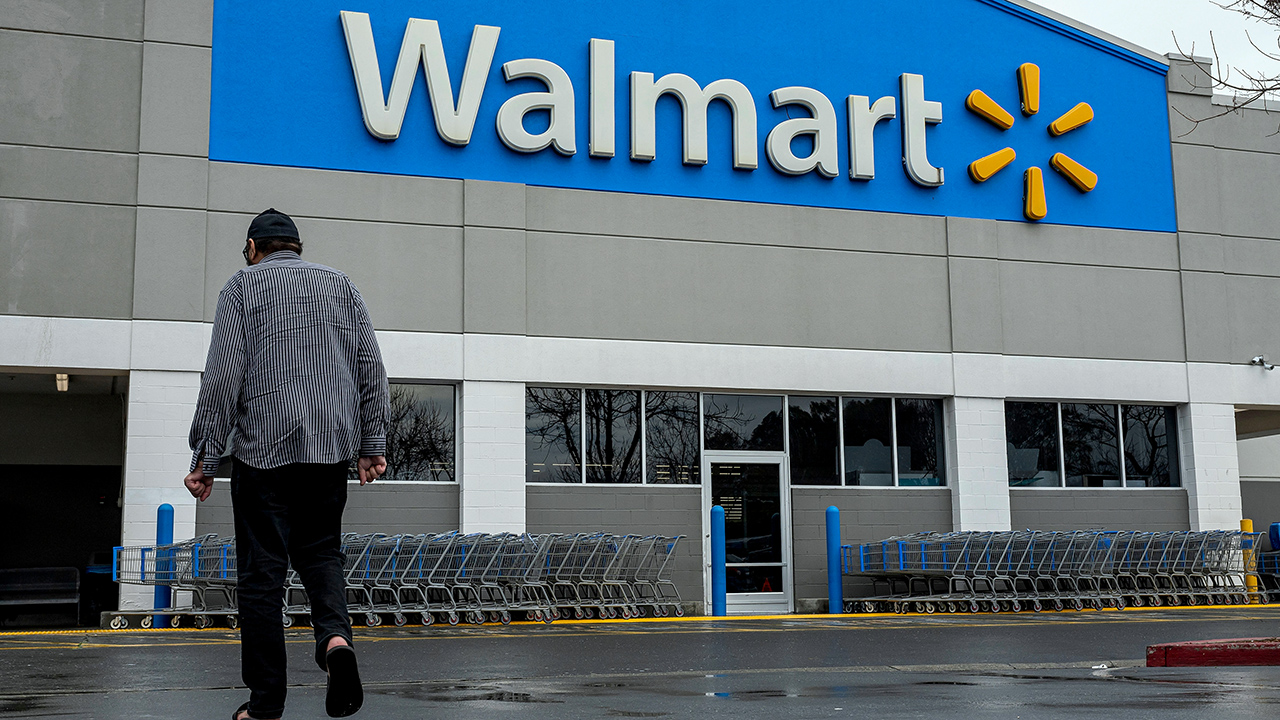Walmart, the world’s largest retailer, recently reported fiscal first-quarter results that saw it surpass analysts’ expectations for earnings, even as sales slightly missed estimates. The Bentonville, Arkansas-based discounter announced adjusted earnings per share of 61 cents against expectations of 58 cents, based on a survey of analysts by LSEG. However, revenue came in at $165.61 billion, just shy of the $165.84 billion expected. Despite the earnings beat, the quarterly sales performance fell just short of estimates. Revenue increased about 2.5% from $161.51 billion in the year-ago period. Net income for the fiscal first quarter fell to $4.49 billion, or 56 cents per share, compared with $5.10 billion, or 63 cents per share, in the prior year’s quarter. This quarter marked Walmart’s first revenue miss since February 2020.
The retailer also maintained its full-year forecast, projecting sales growth of 3% to 4% and adjusted earnings per share between $2.50 and $2.60. This cautious profit outlook had previously disappointed Wall Street in February. For the fiscal second quarter, Walmart anticipates net sales to increase by 3.5% to 4.5%, but chose not to provide guidance for earnings per share or operating income growth, citing fluctuating U.S. tariff policy. The results on the day of the report left Wall Street underwhelmed, with shares closing slightly lower. As of the Wednesday before the report, Walmart shares were up about 7% for the year, outpacing the S&P 500’s roughly flat performance.
Within the quarter’s results, Walmart marked a significant milestone: its e-commerce business achieved profitability for the first time, both in the U.S. and globally. This growth has been bolstered by higher-margin revenue streams, such as online advertising and Walmart’s third-party marketplace. E-commerce sales saw a 21% increase in the U.S., marking the 12th consecutive quarter of double-digit growth. Global e-commerce sales jumped 22% year over year. Comparable sales, also known as same-store sales, saw strong growth, rising 4.5% for Walmart U.S. and 6.7% for Sam’s Club, excluding fuel.
Analyzing consumer behavior and sales patterns, Chief Financial Officer John David Rainey described sales in the quarter as “a little choppy”. He noted that February results were below company expectations, March was closer to what was expected, and April was “a lot stronger”. Early indications for May suggested sales patterns felt “a lot more like April”. While average ticket (amount spent per customer) rose 2.8% year over year and customer transactions increased 1.6% in the U.S. compared to the year-ago period, the growth in customer transactions marked the fourth consecutive quarter of deceleration for this metric, despite overall purchase growth across stores and the website.
The Looming Threat of Tariffs and Potential Price Hikes
A central theme emerging from Walmart’s report and subsequent commentary was the significant impact of tariffs. Chief Financial Officer John David Rainey stated that tariffs are “still too high”. He emphasized that even with a recently announced agreement to lower duties on imports from China to 30% for 90 days, the magnitude of the increases is more than any retailer or supplier can absorb. Rainey voiced concern that consumers would begin seeing higher prices, potentially starting towards the end of the current month and certainly becoming more noticeable in June.
Trade policy remains a major unpredictability for both Walmart and the broader retail industry, influencing decisions on inventory ordering and future tariff level expectations. Roughly a third of the goods Walmart sells in the U.S. are imported from other countries, with China, Mexico, Canada, Vietnam, and India representing the largest import markets. CEO Doug McMillon highlighted that tariffs on China, in particular, create the greatest cost pressure. He pointed out that imports from China are significant in high-volume categories such as toys and electronics. Tariffs on other countries are also causing pressure; for example, tariffs on imports from Costa Rica, Peru, and Colombia are impacting the prices of bananas, avocados, coffee, and roses. In some specific instances, such as flowers at Sam’s Club on Mother’s Day, Walmart has opted to keep prices consistent, even if it means absorbing higher costs.
Rainey explained that Walmart is collaborating with vendors to try and keep prices down. However, he described the situation as “a little bit unprecedented in terms of the speed and magnitude in which the price increases are coming”. Despite the pressure, Walmart plans to “play offense” by maintaining price gaps below competitors. The company intends to absorb some of the higher prices resulting from tariffs and anticipates that its suppliers will also absorb some costs.
Regarding inventory management in the face of tariff uncertainty, Walmart has not canceled any orders. However, it has reduced the size of some purchases. For instance, the company is buying smaller quantities of items it expects may sell less due to a higher, tariff-related price.
Walmart as a Consumer Barometer and Competitive Advantages
Walmart is frequently viewed as an indicator of the health of the U.S. consumer due to its vast network of stores and a diverse customer base spanning various ages, incomes, and regions. Rainey indicated that Walmart has not observed a noticeable shift in consumer behavior compared to previous quarters. He characterized consumers as “discerning,” “mindful,” and perhaps “a little concerned about possible looming price increases,” but noted their behaviors have “largely not changed” as they are “still looking for value”.
In navigating an uncertain economy and attracting selective U.S. consumers, Walmart possesses distinct advantages compared to some of its peers. As the nation’s largest grocer, its sales of food and essential goods contribute to steady store and website traffic. Its established reputation as a value provider allows it to attract customers across different income brackets, including middle- and upper-income shoppers seeking lower prices. Walmart has actively attracted wealthier shoppers through initiatives like faster deliveries, store remodels, and offering a wider assortment of brands. Beyond traditional retail, the company has also been growing profits faster than sales by expanding into newer businesses such as advertising and its subscription service, Walmart+. Sales for its U.S. advertising business, Walmart Connect, increased 31% year over year in the first quarter, excluding the Vizio smart TV business acquired last year.
Walmart’s quarterly report often serves as the first in a series of updates from major retailers, with companies like Target, Home Depot, and Lowe’s typically reporting their earnings in the following week. These reports provide investors and economists further insight into the strength of the U.S. consumer and the broader impact of higher tariffs on the retail sector.
Political Response to Potential Price Increases
Walmart’s announcement regarding potential price increases due to tariffs quickly drew a reaction from President Trump. On a Saturday following Walmart’s earnings report, President Trump publicly criticized the retailer’s plan, demanding that it absorb the tariff costs instead of passing them on to consumers. This response underscores the White House’s focus on managing the risk of tariff-driven inflation and its willingness to publicly pressure retailers to keep prices in check.
According to a source close to Walmart, the idea that costs were reaching a point where they could no longer be easily absorbed was not new to the administration; Walmart had previously communicated this concern to the White House without encountering pushback at the time.
President Trump used Truth Social to voice his displeasure, stating, “Walmart should STOP trying to blame Tariffs as the reason for raising prices throughout the chain”. He argued that “Walmart made BILLIONS OF DOLLARS last year, far more than expected”. He further demanded that “Between Walmart and China they should, as is said, ‘EAT THE TARIFFS,’ and not charge valued customers ANYTHING”. President Trump concluded by warning, “I’ll be watching, and so will your customers!!!”.
This public confrontation followed less than a month after Walmart’s CEO, along with other key retail executives, had privately warned the president that tariffs could soon result in empty shelves and higher prices. That earlier warning was reportedly viewed as a key factor in a subsequent shift towards a softer tone from the president on trade matters. However, just days later, the White House had criticized a report about Amazon potentially showing customers the price impact of tariffs as “hostile and political” – a plan Amazon later denied. This was also contrasted by Commerce Secretary Howard Lutnick who, the weekend prior, had reportedly ridiculed arguments suggesting consumers would pay higher prices due to tariffs, only for the nation’s largest retailer to announce just that four days later.
Walmart did not specify precisely when or by how much prices would rise, or on exactly which items, allowing some flexibility. However, the changes were expected to begin appearing in the next couple of weeks. A Walmart spokesperson responded to the public pressure by stating, “We have always worked to keep our prices as low as possible and we won’t stop. We’ll keep prices as low as we can for as long as we can given the reality of small retail margins”.
Other Developments from the Trump Administration
In separate developments reported alongside the Walmart/tariff news, the Trump administration made announcements regarding gun control and federal employee rights.
The Justice Department reached a settlement that ends litigation filed by the Biden administration to block the sale of a device known as a forced-reset trigger. Attorney General Pam Bondi stated that the Department of Justice believes the Second Amendment is “not a second-class right” and expressed satisfaction in ending the litigation cycle with a settlement intended to “enhance public safety”.
Forced-reset triggers enable owners of semiautomatic weapons to fire at a rapid rate. Biden administration officials had previously stated that aided by this device, a shooter could fire hundreds of rounds in a minute with an extended squeeze. The accessory is described as similar to a bump stock, which President Trump banned during his first term after one was used in the Las Vegas shooting. Both devices allow semiautomatic rifles to achieve firing speeds comparable to machine guns. The Supreme Court struck down the bump stock ban the previous year, but the Biden administration had sought to maintain a ban on forced-reset triggers. A federal judge in Texas had struck down the forced-reset trigger ban, a ruling the Biden administration had appealed. The new settlement includes gun-safety provisions and prevents the sale of forced-reset triggers in pistols. Despite these provisions, gun safety advocates criticized the settlement, arguing it allows gun owners to convert their firearms into “virtual machine guns,” thereby making life in America more dangerous. John Feinblatt, president of Everytown for Gun Safety, commented that “Machine guns have no place on our streets, and this move from the Trump administration will only lead to tragedy”.
Additionally, a federal appeals court lifted a lower court’s injunction on President Trump’s executive order that removes hundreds of thousands of federal employees’ right to collectively bargain. The U.S. Court of Appeals for the District of Columbia ruled that the affected workers had not demonstrated they would suffer the kind of irreparable harm necessary to justify the original injunction. The appeals panel also reasoned that allowing the order to take effect would help preserve presidential authority on national security matters “within the public interest”. The executive order, signed in March, had faced immediate opposition from unions aiming to protect workers from potential mass layoffs across the federal government.
In conclusion, Walmart’s recent earnings report highlighted a mixed financial performance tempered by the growing challenge posed by tariffs. While the retailer achieved a milestone with e-commerce profitability and demonstrated resilience through its core grocery and value offerings, the potential necessity of raising prices due to unabsorbable tariff costs introduced significant uncertainty for the future. This led to a public confrontation with President Trump, underscoring the tension between trade policy, corporate costs, and consumer prices. Alongside these economic and political developments, the administration also saw legal outcomes regarding gun control measures and federal employee collective bargaining rights.

